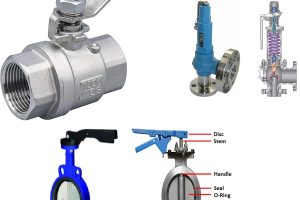For your solar system to work correctly and efficiently, you must connect the batteries and panels rightly. A wrong connection does not only reduce the efficiency of the system, it can also damage some of the fragile solar system components, especially the inverter. For example, your solar system will not work if you connect a battery bank of 48V or 36V effective voltage to a 24V inverter system. In this article, you will learn the various ways to connect your solar batteries and panels for optimal performance of the solar PV system.
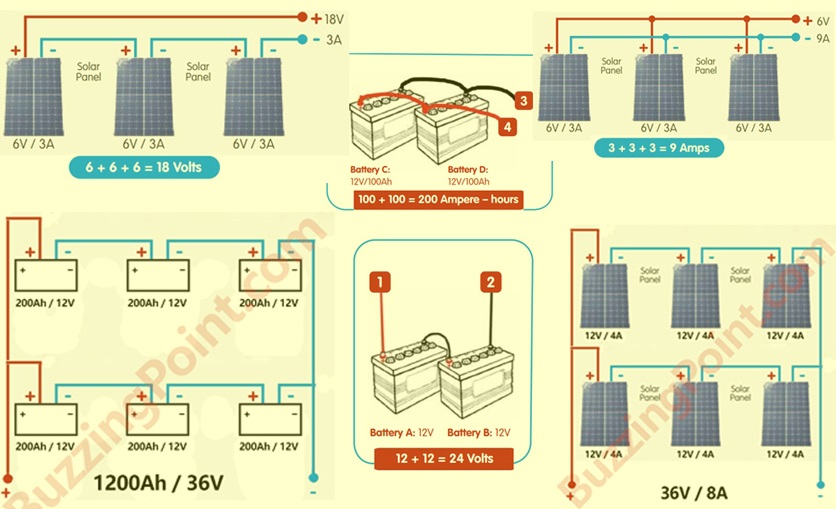
Various Ways to Connect Solar Cells
This guide does not only apply to solar batteries and solar panels. It also applies to any type of cell.
There are 3 possible ways you can connect your solar batteries and panels. They include:
- Series Connection
- Parallel Connection
- Series-Parallel (Mixed) Connection
When cells are connected in series, the effective voltage is simply the algebraic sum of the voltage of the individual components (panels or batteries). While the effective current is same as the current that flow through one of the components.
That is; VT = V1 + V2 + V3 + … + Vn
IT = I1 = I2 = I3 = In
When cells are connected in parallel, the effective current is simply the algebraic sum of the current of the individual components (panels or batteries). While the effective voltage is same as the voltage of one of the components.
That is; IT = I1 + I2 + I3 + … + In
VT = V1 = V2 = V3 = Vn
When cells are connected in series-parallel, the effective voltage and current depends on the number of branches in the connection. For example, if four 12V, 4A PV cells (panels or batteries) are connected in series-parallel style (that is 2 cells are first connected in series, another 2 are also connected in series, then the 2 series branches are then connected in parallel), the effective voltage will be the effective voltage of any of the series branches (that is 12 + 12 = 24). While the effective or total current flowing in the entire circuit will be algebraic sum of the effective current flowing through each of the 2 series branches in the circuit (that is 4 + 4 = 8A).
NOTE:
In any of the connection types (series, parallel and series-parallel), the total power or wattage of the components (batteries and panels) is the algebraic sum of the individual components.
That is; PT = P1 + P2 + P3 + … + Pn
Also note that the 40% power loss during battery charging was neglected here.
The above formulas (for series, parallel and series-parallel connection types) are correct if and only if each of the connected components have the same rating, both in terms of voltage and current.
How to Connect Cells in Series
To connect two cells (batteries or panels) in series, you connect the positive terminal of the first cell to the negative terminal of the second cell. You will now have two terminals left (positive and negative) to connect to the load, the inverter or the charge controller.
The screenshot below shows how to connect 2 batteries in series.
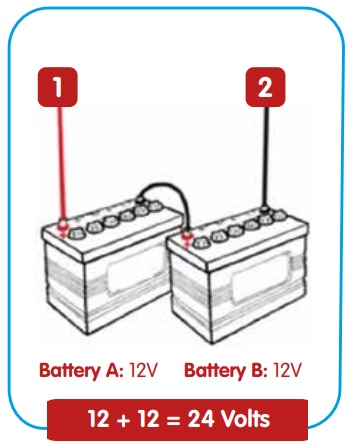
The screenshot below shows how 3 solar panels are connected in series.
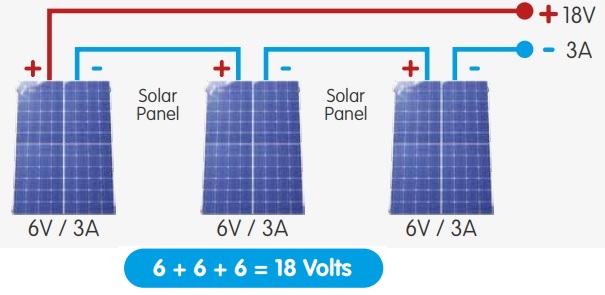
Use the above concept for any number of cells you wish to connect in series. If you require higher voltage, then connect your cells in series.
How to Connect Cells in Parallel
To connect two cells (batteries or panels) in parallel, you connect the positive terminal of the first cell to the positive terminal of the second cell. You can now use the positive and negative terminals of any of the cells (both terminals should come from the same cell) to connect the load, the inverter or the charge controller.
The screenshot below shows how to connect 2 batteries in parallel.
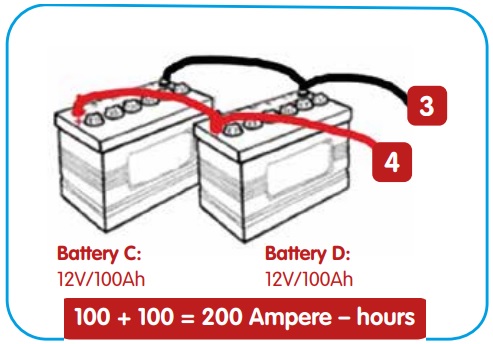
The screenshot below shows how 3 solar panels are connected in parallel.
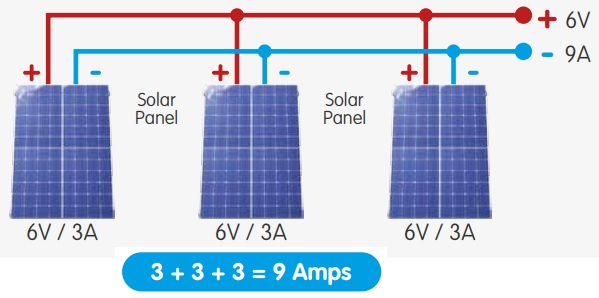
Use this concept for any number of cells you wish to connect in parallel. If you require high current, then connect your cells in parallel.
How to Connect Cells in Series-Parallel
To connect 4 cells (batteries or panels) in series-parallel, you connect the first 2 cells in series. Next, you connect the other two cells in series also. Then you join the free positive of the first set of cells to the free positive of the second set of cells. You also join the free negative of the first set of cells to the free negative of the second set of cells. These two joints (positive and negative) are where you can connect your load, inverter or charge controller.
The screenshot below shows how batteries are connected in series-parallel.
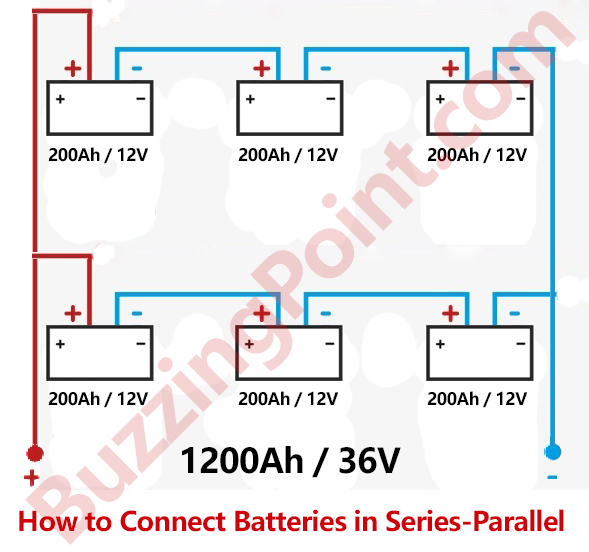
The screenshot below shows how solar panels are connected in series-parallel.
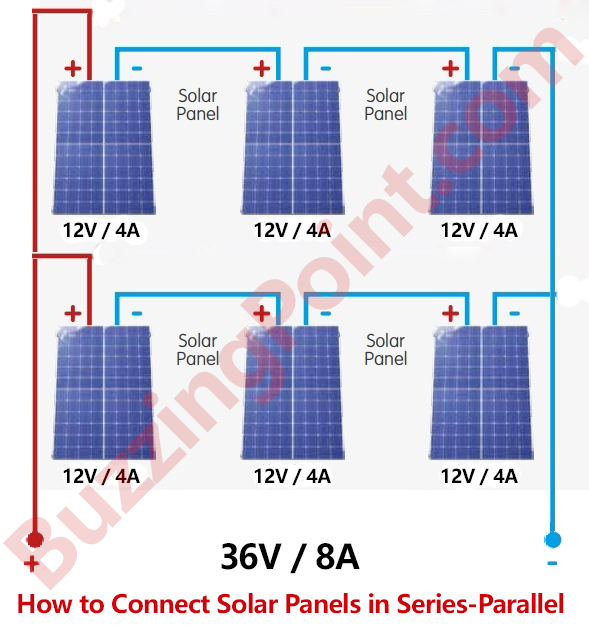
Use this concept for any number of cells you wish to apply series-parallel connection. But make sure the total number of cells you are connecting is an even number, from 4 and above (4, 6, 8, 10, etc.).
How to Connect Solar Batteries and Panels of Varying Ratings
It is always advisable to only connect solar panels and batteries that are of the same brand, equal in power, voltage and current ratings. This is because connecting a weak cell (battery or panel) affects the performance of the entire cell bank (solar array or battery bank).
For example, connecting a 20V/5A cell with three other 24V/8A similar cells in series will result to an effective current of 5A (current rating of the weakest element). The effective voltage will be (3 x 24) + 20 = 92V. Also, the total power will be 5 x 92 = 460W.
Whereas if the ratings of the 4 cells were equal (say 24V/8A), the effective current would be 8A, the effective voltage would be 96V, while the total power will be 8 x 96 = 768W
The power difference is 768 – 460 = 308W
Similarly, connecting a 20V/5A cell with three other 24V/8A similar cells in parallel will result to an effective voltage of 20V (voltage rating of the weakest element). The effective current will be (3 x 8) + 5 = 29A. Also, the total power will be 29 x 20 = 580W.
Whereas if the ratings of the 4 cells were equal (say 24V/8A), the effective voltage would be 24V, the effective current would be 32A, while the total power will be 32 x 24 = 768W.
The power difference is 768 – 580 = 188W
This is to show you how the introduction of any weak cell in a cell bank affects the entire system.
From the above example, the following should be noted:
- If you must connect dissimilar cells (panels or batteries) in series, then make sure all the cells have equal current rating.
- Similarly, if you must connect dissimilar cells (panels or batteries) in parallel, then make sure all the cells have equal voltage rating.
- For both series and parallel connections, adding a cell (panel or battery) of lower rating reduces the total output power of the cell bank or system. The lower the rating, the higher the output power loss.
- When connecting cells of different brands in series, make sure they have the same current rating.
- Also, when connecting cells of different brands in parallel, make sure they have the same voltage rating.
See:
- Solution to All Solar PV Systems Installation Calculations
- How to Choose the Best Solar Batteries & Panels for your System
Conclusion
You have learnt the various ways to connect your solar batteries and panels in a solar system. These tips can be applied when connecting any cell, both in electrical and electronic systems. If you need more voltage, connect the cells in series. For more current, connect the cells in parallel. If you want to manipulate both the current and voltage to suit your need, then connect the cells in series-parallel.
Did you find any section of this article confusing? Ask your questions in the comment section below. Don’t forget to subscribe to our blog via email to stay up to date with our upcoming tutorial articles. Share this article with your social media friends by clicking a share button. Enjoy!
Follow us on social media




